Within the state of Utah you can discover seven national monuments. When visiting these monuments you will discover Utah's natural beauty and prehistoric past. For more information about each monument, follow the links below.
Cedar Breaks National Monument
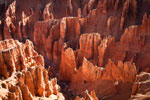 A huge natural amphitheater has been eroded out of the variegated Pink Cliffs (Claron Formation) near Cedar City, Utah. Millions of years of sedimentation, uplift and erosion have created a deep canyon of rock walls, fins, spires and columns, that spans some three miles, and is over 2,000 feet deep. The rim of the canyon is over 10,000 feet above sea level, and is surrounded by the Dixie National Forest.
A huge natural amphitheater has been eroded out of the variegated Pink Cliffs (Claron Formation) near Cedar City, Utah. Millions of years of sedimentation, uplift and erosion have created a deep canyon of rock walls, fins, spires and columns, that spans some three miles, and is over 2,000 feet deep. The rim of the canyon is over 10,000 feet above sea level, and is surrounded by the Dixie National Forest.
Dinosaur National Monument
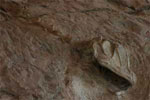 Dinosaur National Monument protects a large deposit of fossil dinosaur bones--remains of the so-called "terrible lizards" that lived millions of years ago. The dinosaurs weren't really lizards, and most of them weren't even terrible. But some of the first dinosaur fossils ever found were huge bones and teeth, very lizard-like except for their size, and so the idea of monstrous lizards was born.
Dinosaur National Monument protects a large deposit of fossil dinosaur bones--remains of the so-called "terrible lizards" that lived millions of years ago. The dinosaurs weren't really lizards, and most of them weren't even terrible. But some of the first dinosaur fossils ever found were huge bones and teeth, very lizard-like except for their size, and so the idea of monstrous lizards was born.
Grand Staircase National Monument
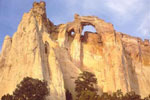 In September of 1996, President Clinton designated this huge national monument, which at 1.9 million acres dominates any map of Southern Utah. The monument is a geologic sampler, with a huge variety of formations, features, and world-class paleontological sites. The Grand Staircase is a geological formation spanning eons of time and is a territory of multicolored cliffs, plateaus, mesas, buttes, pinnacles, and canyons.
In September of 1996, President Clinton designated this huge national monument, which at 1.9 million acres dominates any map of Southern Utah. The monument is a geologic sampler, with a huge variety of formations, features, and world-class paleontological sites. The Grand Staircase is a geological formation spanning eons of time and is a territory of multicolored cliffs, plateaus, mesas, buttes, pinnacles, and canyons.
Hovenweep National Monument
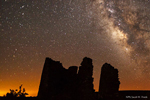 Hovenweep National Monument protects five prehistoric, Puebloan-era villages spread over a twenty-mile expanse of mesa tops and canyons along the Utah-Colorado border. The multi-story towers perched on canyon rims and balanced on boulders lead visitors to marvel at the skill and motivation of their builders. Hovenweep is noted for its solitude and undeveloped, natural character.
Hovenweep National Monument protects five prehistoric, Puebloan-era villages spread over a twenty-mile expanse of mesa tops and canyons along the Utah-Colorado border. The multi-story towers perched on canyon rims and balanced on boulders lead visitors to marvel at the skill and motivation of their builders. Hovenweep is noted for its solitude and undeveloped, natural character.
Natural Bridges National Monument
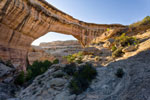 Natural Bridges protects some of the finest examples of ancient stone architecture in the southwest. The monument is located in southeast Utah on a pinyon-juniper covered mesa bisected by deep canyons of Permian age Cedar Mesa Sandstone. Where meandering streams cut through the canyon walls, three natural bridges formed: Kachina, Owachomo and Sipapu.
Natural Bridges protects some of the finest examples of ancient stone architecture in the southwest. The monument is located in southeast Utah on a pinyon-juniper covered mesa bisected by deep canyons of Permian age Cedar Mesa Sandstone. Where meandering streams cut through the canyon walls, three natural bridges formed: Kachina, Owachomo and Sipapu.
Rainbow Bridge National Monument
 Rainbow Bridge is the world's largest natural bridge. The span has undoubtedly inspired people throughout time--from the neighboring American Indian tribes who consider Rainbow Bridge sacred, to the 300,000 people from around the world who visit it each year. Please visit Rainbow Bridge in a spirit that honors and respects the cultures to whom it is sacred.
Rainbow Bridge is the world's largest natural bridge. The span has undoubtedly inspired people throughout time--from the neighboring American Indian tribes who consider Rainbow Bridge sacred, to the 300,000 people from around the world who visit it each year. Please visit Rainbow Bridge in a spirit that honors and respects the cultures to whom it is sacred.
Timpanogos Cave National Monument
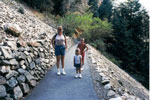 Timpanogos Cave National Monument sits high in the Wasatch Mountains (The Uinta National Forest). The cave system consists of three spectacularly decorated caverns. Each cavern has unique colors and formations. Helictites and anthodites are just a few of the many dazzling formations to be found in the many chambers. As visitors climb to the cave entrance, on a hike gaining over 1,000 feet in elevation, they are offered incredible views of American Fork Canyon.
Timpanogos Cave National Monument sits high in the Wasatch Mountains (The Uinta National Forest). The cave system consists of three spectacularly decorated caverns. Each cavern has unique colors and formations. Helictites and anthodites are just a few of the many dazzling formations to be found in the many chambers. As visitors climb to the cave entrance, on a hike gaining over 1,000 feet in elevation, they are offered incredible views of American Fork Canyon.